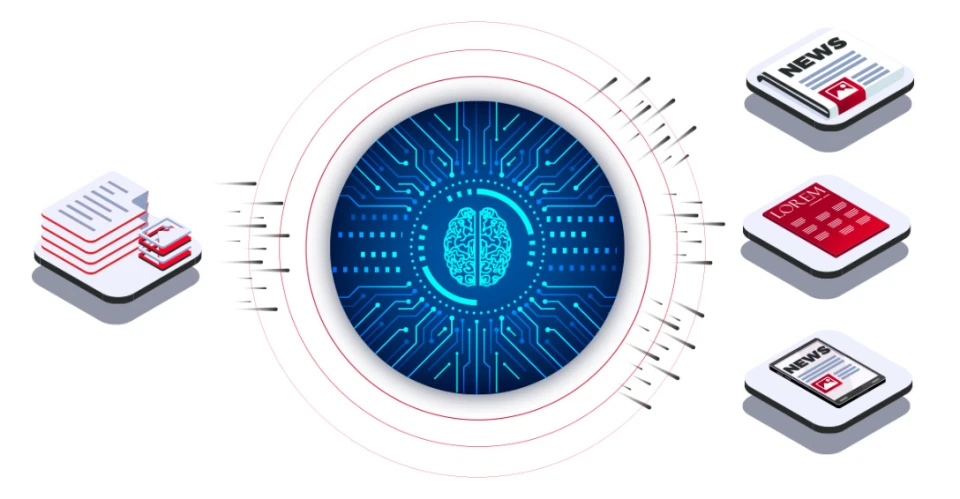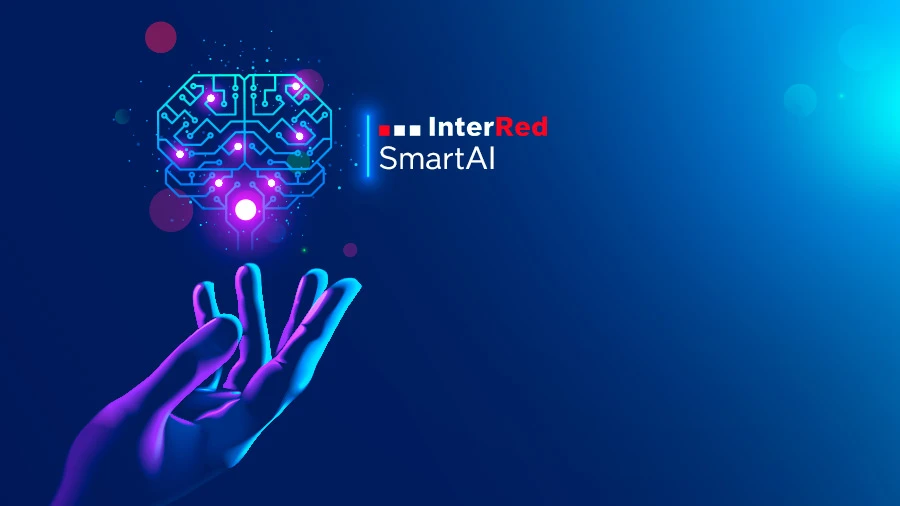
Print Automation
Automatic layout, print automation with AI: The InterRed editorial system offers the special highlight of automated creation of print products. Generate newspapers, magazines, e-papers and print products such as flyers, brochures and catalogues fully automatically and without additional effort, opening up completely new perspectives. This is made possible for the first time by InterRed SmartPaper – with a potential saving of 60 minutes per page.
InterRed SmartPaper: Automatic layout, print automation with AI
The future of print automation has begun - and it's called InterRed SmartPaper. With advanced technology based on artificial intelligence, newspapers, magazines, e-papers and other print layout-based products can be created fully automatically and cost-effectively. InterRed SmartPaper thus offers a ground-breaking solution that takes media production to a new level. The automated creation of print products without additional costs opens up completely new perspectives for publishers and companies in all sectors.

Print automation at the highest level
With InterRed SmartPaper, print automation is easier and smarter than ever before. The system enables automated content selection and automated page layout, which greatly speeds up and simplifies the entire production process. By defining the degrees of freedom, you retain full control over the process while the AI does the work in the background.
1 hour of potential savings per page
The use of InterRed SmartPaper significantly reduces the production time per print page. Thanks to optimised workflows prior to the actual layout and subsequent layout creation, a total of one hour per page can be saved. Our customer, Rheinische Post Mediengruppe, confirms a time saving of around 30 minutes per page for layout alone – as presented in a lecture at the European Publishing Congress 2025 in Vienna. This combined efficiency gain enables editorial teams to produce large page volumes with considerably less effort, conserve resources and create more space for journalistic quality and creative content.
AI layout: The "face" of the print product is retained
With InterRed SmartPaper, you can be sure that the print layouts and print products created meet the exact requirements. The corporate design is adhered to so that the "face" of the print products is always retained. Whether it's a newspaper, magazine, e-paper or other print media - thanks to the intelligent automation of InterRed SmartPaper, the products created always look the way they should and present your brand with a consistent and professional appearance.
Automated page layout, Automatic Pagination
Thanks to InterRed SmartPaper's automated page layout, designing print products becomes an effortless and efficient process. The software takes care of the placement of text, images and other elements on the pages fully automatically. Attention is paid not only to aesthetics, but also to an intuitive layout that optimizes readability and visual flow. This saves valuable time and offers the reliability that every layout is professionally and attractively designed.
Cost-effective solution for every need
InterRed SmartPaper not only offers efficient automation of print products, but also enables significant cost savings. The automated processes not only reduce production times, but also the associated personnel costs. It also eliminates the need for manual corrections and adjustments, which minimizes errors and avoids additional expenses. The ability to create print products without additional work significantly reduces overall costs and makes InterRed SmartPaper a cost-effective solution for publishers and companies. This leaves more room to make optimal use of creative capacities and focus on creating high-quality content that inspires and retains readers and customers.
Efficient print automation for marketing and sales
Companies from all sectors (e.g. industry, trade, services) can use InterRed SmartPaper to create their printed advertising and information materials more efficiently than ever. Whether product catalogues, brochures or inserts: automated creation saves time, reduces costs and ensures consistently high quality. Thanks to intelligent integration into existing marketing and sales systems, content can be produced at any time in a way that is up to date, CI-compliant and target group-specific. This makes print and e-paper a flexible and cost-efficient component of any communication strategy.
Artificial intelligence: SmartAI - sticks to boundaries you can rely on
This technology, which works with the support of artificial intelligence (AI), is revolutionizing print production. At the same time, the typical appearance of the print edition is retained. This also enables the optimal implementation of publishing strategies such as Digital First. With such approaches focused on digital publishing, the AI-based possibilities for automation achieve great advantages and can significantly increase the efficiency of print production. Since a large part of the work involved in creating print pages is in the layout area, there is great potential for optimizing the corresponding workflows.
The functions of the InterRed publishing solution free editors and layout designers from the time-consuming task of writing one line of articles after another. As a completely browser-based editorial system, the possibilities of InterRed are available in the browser, regardless of location and can be used flexibly. Online or agency content can be selected automatically according to certain specifications (e.g. KPIs). Everything else is handled by the integrated AI solution, an artificial intelligence called SmartAI. This adheres to limits that you can rely on. The fact that, for example, newspapers created at the touch of a button retain their typical appearance is a decisive advantage. AI methods follow rules that are very easy to define. Once defined, the AI does not perform any layout operations beyond the specified limits, so the software controls itself. Among other things, InterRed SmartPaper uses the artificial intelligence of InterRed ContentAgents and thus the InterRed SmartAI technologies for automation.

Pure AI requires too much checking
Fully automated layouts based exclusively on generative AI models produce an impressive variety of designs, but without reliable compliance with corporate design rules, readability standards or content priorities. Elements may be randomly too large, too small or incorrectly placed, and colours and typography may deviate from the brand image.
In professional publishing processes, this leads to a considerable amount of manual checking and correction work, which negates the advantage of automation. Pure AI is therefore not economically viable, especially in environments with strict CI guidelines and legal requirements.
Rule-based alone offers too little automation potential
Purely rule-based layout systems, such as those based on template or constraint logic, deliver consistent and reliable results, but quickly reach their creative and technical limits. Since they only process predefined rules, they lack the ability to dynamically adapt to different amounts of content, text lengths or emotional image statements.
The result is rigid layouts with limited flexibility and a low degree of automation. Only the combination of rules and AI intelligence, as implemented by SmartPaper, enables efficient, brand-compliant and adaptive layout automation.
Conclusion: Hybrid is the key
Neither pure AI nor pure rulesets alone can meet the requirements of modern print and content automation. AI-based systems generate too many unpredictable results and therefore require a high level of testing, while purely rule-based approaches are reliable but too inflexible to optimally design complex or varying content.
The greatest efficiency gains come from the hybrid approach of InterRed SmartPaper: artificial intelligence makes adaptive, semantic decisions, for example in weighting and layout suggestions, while defined rules ensure brand and design conformity. This results in maximum automation with consistent quality and a consistent brand image.
Our frequently asked questions provide comprehensive insight into topics related to print automation, layout creation, AI support and workflow optimisation with InterRed SmartPaper. Here we explain in detail how automated production processes work, what advantages they offer and how the InterRed solution can be integrated into existing systems.
Click on a question to open the corresponding answer and learn more about the possibilities, application examples and technical background of InterRed SmartPaper.
For us, print automation describes the process in which the selection, preparation and layout creation of content for printed and multimedia publications is largely automated. InterRed links structured content sources (e.g. CMS exports, online articles or DAM data) with predefined layout templates, boundaries and rules, as well as the various InterRed ContentAgents (SmartAI), so that articles, images, metadata, etc. are automatically placed in the right places, typographically adjusted and exported as print-ready outputs or e-papers. The aim is to reduce manual DTP work, ensure consistency in brand and format implementation, and significantly shorten production cycles. Our implementations also take editorial workflows into account and offer options for human fine-tuning and quality assurance, so that automation and editorial control go hand in hand. Our AI control instance ensures that the AI adheres to rules and does not deliver undesirable results.
The automation of layout and production steps creates several tangible advantages: shortened time-to-publish, reduced manual correction loops, consistent CI compliance, and scalable production across multiple distribution channels. The use of the reliable InterRed AI reduces the error rate for recurring tasks, while at the same time increasing the speed of production for newspapers, magazines, catalogues and even regionalised layouts. For editorial teams, this means less routine work, for production teams less coordination effort, and for the business better predictability in terms of costs and delivery times. In addition, InterRed enables simple multiple outputs (print, e-paper, other digital channels) without multiple manual effort, which brings significant efficiency gains, especially with high volumes or frequent update cycles.
The InterRed solution is designed for all formats that need to convert online, agency, CMS and other content into layouts: daily and weekly newspapers, magazines, journals, catalogues, brochures, business and annual reports, and e-paper editions. Marketing departments, agencies and print service providers can also use the platform for their print products. The AI-based solution is designed to reliably map both very short-cycle productions with a high number of pages and detailed catalogue productions with many product variants.
The specific ROI depends on the initial situation, in particular the previous degree of manualisation, the number of recurring layout tasks and the complexity of integrations and approval processes. In many projects, we see a noticeable reduction in layout hours per issue and a reduction in the frequency of errors through automated checks; Typical effects include accelerated turnaround times, lower production costs, and less to no rework. Thanks to the implementation of optimised workflows with InterRed before the actual layout and the subsequent automated layout creation, a total of one hour per page can often be saved. For layout alone, our customer, the Rheinische Post Mediengruppe, confirms a time saving of around 30 minutes per page.
InterRed's flexible and open architecture makes it open to standard interfaces and custom connections: REST APIs, XML/CSV imports and exports, connections to external PIM and DAM systems, and direct connections to ad and sales management. InterRed provides common output formats for pre-press. Technically, ERP and CRM systems as well as external asset libraries can also be connected to keep data and asset flows consistent.
Yes. The InterRed plugins designed for Adobe InDesign and Adobe InCopy allow users to work directly with the familiar DTP applications. Thanks to the two-way integration with InterRed, content can be created or edited in both the editorial system or print automation solution and in the DTP programme, and is immediately available on both platforms.
AI is an integral part of our efforts to increase efficiency and improve quality. InterRed's AI recognises image content, can shorten and optimise texts, and provides background support or active assistance with user queries. A key advantage here, however, is the control instance that ensures that the AI adheres to specifications. This effectively minimises the error rate that many AI solutions often entail. InterRed uses AI modules to speed up routine decisions and relieve the burden on employees; the final quality control and editorial decision usually remains anchored in human hands (human-in-the-loop).
Print automation fundamentally changes work processes by reducing routine tasks and making workflows more transparent. Editorial and production teams can focus more on content and design quality, while recurring tasks such as the entire layout, including formatting, image placement and data transfer, are performed automatically. This makes the entire workflow more predictable, simplifies communication between editorial, layout and pre-press, and allows changes to be implemented more quickly. At the same time, new opportunities arise for planning content across channels – for example, by creating print and digital editions in parallel from a common database. This significantly increases the efficiency and consistency of published content.
Clean data structures, clearly defined workflows and an open understanding of change processes are crucial for successful implementation. Companies should organise their existing systems (e.g. CMS, PIM, DAM) in such a way that content is structured, consistent and easily accessible. From an organisational perspective, it is also important to define responsibilities and approval processes in order to integrate automation smoothly into everyday work. A step-by-step approach – for example, through pilot projects or partial automation – helps to gain experience and familiarise employees with the new processes. With clearly defined goals and internal acceptance, print automation can be implemented successfully and sustainably.
Print automation complements digital workflows perfectly because it is based on the same structured data that is also used for web, app or social media channels. Content can thus be reused multiple times, automatically adapted and played out in various output channels. This reduces redundancies and ensures a uniform content basis across all media. Publishers and communications departments in particular benefit from the fact that print and online content can be controlled from a single system. This not only makes the production process more efficient, but also more strategically networked – print becomes part of a consistent digital content strategy.
Print automation creates the technological basis for genuine cross-media strategies. When content is maintained centrally and automatically transferred to different formats, synergies arise between print, web and mobile. This allows editorial articles, product information or campaign messages to appear consistently across channels, while the layout and tone are adapted to the respective medium. Print is thus not isolated, but becomes part of an integrated content architecture. For companies and publishers, this means stronger brand awareness, shorter response times and greater flexibility in the planning and implementation of publications.
The most common challenges include organisational changes, adapting existing processes and managing expectations correctly. Automation usually requires a rethink in editing and production – from manual design to rule-based workflows. This change is most successful when all those involved are involved and trained at an early stage. Clear communication of goals and benefits is also crucial to gaining acceptance. Technically, it is important to clearly define interfaces and ensure data quality. These challenges can be successfully overcome through gradual implementation, accompanying change management, and continuous evaluation.
InterRed SmartPaper is a central component in digital transformation because it combines classic print processes with modern, data-driven workflows. It helps companies to bring their content into a future-proof structure and overcome the boundaries between print, e-paper and digital publication channels. Through integration into existing editorial and content systems, print is no longer viewed in isolation, but rather as part of a continuously digitally controlled production chain in which e-paper editions can also be automatically created and updated. This increases flexibility, boosts efficiency and creates new opportunities for data-based evaluations and optimisations. SmartPaper supports companies in sustainably modernising their editorial, production and marketing-related processes and aligning them with the requirements of a networked publishing environment.
InterRed SmartPaper makes it possible to automatically generate e-paper editions of newspapers and magazines from the same content that is used for the printed title. This eliminates the need to maintain articles, images and layouts twice – the content is created once and can then be prepared for both print and e-paper. The system automatically takes care of the layout of the digital pages, taking into account the structure, arrangement and typography of the print edition and converting it into an optimised digital format.
For publishers, this means considerable time and cost savings, as production processes are standardised and redundant work steps are avoided. At the same time, readers benefit from the rapid digital availability of current editions – often at the same time as or even before the print date. With InterRed SmartPaper, different output variants, such as regional or topic-specific versions, can also be generated without additional effort. This makes the e-paper an integral part of a modern, automated publication strategy that intelligently combines print and digital.
For marketing and communications teams, print automation with InterRed offers the opportunity to implement campaigns faster, more consistently and in a more targeted manner. Product catalogues, flyers or brochures can be generated automatically based on existing data without having to create each layout manually. This means that more variants can be produced in less time – such as regional versions or individual offers. In addition, brand communication is strengthened because corporate design guidelines are automatically adhered to. The resources freed up can then be channelled into creative and strategic tasks, while routine tasks are taken over by automation. The result: faster market launch, lower costs and an overall higher quality of communication.
Ready for the future of print automation?

Are you interested?
Contact us. We look forward to your message.




